Lysosomal Activation Mediated by Endocytosis in J774 Cell Culture Treated with N-Trimethyl Chitosan Nanoparticles
Abstract
:1. Introduction
2. Results and Discussion
2.1. Characterization of TMC Nanoparticles and TMC/BSA Loaded Nanoparticles
2.2. Effects of TMC-NP on Cell Proliferation
2.3. Confocal Microscopy of Live Cells
3. Materials and Methods
3.1. Materials
3.2. TMC Synthesis
3.3. TMC Nanoparticle Synthesis Using Microfluidic Technique
3.4. TMC Nanoparticle Characterization
3.5. Cell Culture, Proliferation Assay, and Endocytosis of TMC-NP
3.6. Statistical Analyses
4. Conclusions
Supplementary Materials
Author Contributions
Funding
Institutional Review Board Statement
Informed Consent Statement
Data Availability Statement
Acknowledgments
Conflicts of Interest
References
- Kumar, B.P.; Chandiran, I.S.; Bhavya, B.; Sindhuri, M. Microparticulate drug delivery system: A review. Indian J. Pharm. Sci. Res. 2011, 1, 19–37. [Google Scholar]
- Rizvi, S.A.A.; Saleh, A.M. Applications of nanoparticle systems in drug delivery technology. Saudi Pharm. J. 2018, 26, 64–70. [Google Scholar] [CrossRef] [PubMed]
- Gupta, R.K.; Siber, G.R. Adjuvants for human vaccines-current status, problems and future prospects. Vaccine 1995, 13, 1263–1276. [Google Scholar] [CrossRef] [PubMed]
- Reed, S.G.; Orr, M.T.; Fox, C.B. Key roles of adjuvants in modern vaccines. Nat. Med. 2013, 19, 1597–1608. [Google Scholar] [CrossRef]
- Kumacheva, E. Microfluidic Reactors for Polymer Particles; Wiley: Hoboken, NJ, USA, 2011. [Google Scholar] [CrossRef]
- Tenorio-Barajas, A.Y.; Olvera, M.d.l.L.; Romero-Paredes, G.; Altuzar, V.; Garrido-Guerrero, E.; Mendoza-Barrera, C. Chitosan, Chitosan/IgG-Loaded, and N-Trimethyl Chitosan Chloride Nanoparticles as Potential Adjuvant and Carrier-Delivery Systems. Molecules 2023, 28, 4107. [Google Scholar] [CrossRef]
- Peniche, H.; Acosta, N. Chitosan: An Attractive Biocompatible Polymer for Microencapsulation. Macromol. Biosci. 2003, 3, 511–520. [Google Scholar] [CrossRef]
- Amidi, M.; Romeijn, S.G.; Borchard, G.; Junginger, H.E.; Hennink, W.E.; Jiskoot, W. Preparation and characterization of protein-loaded N-trimethyl chitosan nanoparticles as nasal delivery system. J. Control. Release 2006, 111, 107–116. [Google Scholar] [CrossRef] [PubMed]
- Sieval, A.B.; Thanou, M.; Kotzé, A.F.; Verhoef, J.C.; Brussee, J.; Junginger, H.E. Preparation and NMR characterization of highly substituted N-trimethyl chitosan chloride. Carbohydr. Polym. 1998, 36, 157–165. [Google Scholar] [CrossRef]
- Jearanaiwitayakul, T.; Sunintaboon, P.; Chawengkittikul, R.; Limthongkul, J.; Midoeng, P.; Chaisuwirat, P.; Warit, S.; Ubol, S. Whole inactivated dengue virus-loaded trimethyl chitosan nanoparticle-based vaccine: Immunogenic properties in ex vivo and in vivo models. Hum. Vaccines Immunother. 2021, 17, 2793–2807. [Google Scholar] [CrossRef]
- Nicolete, R.; Santos, D.F.D.; Faccioli, L.H. The uptake of PLGA micro or nanoparticles by macrophages provokes distinct in vitro inflammatory response. Int. Immunopharmacol. 2011, 11, 1557–1563. [Google Scholar] [CrossRef]
- Huang, M.; Khor, E.; Lim, L.Y. Uptake and Cytotoxicity of Chitosan Molecules and Nanoparticles: Effects of Molecular Weight and Degree of Deacetylation. Pharm. Res. 2004, 21, 344–353. [Google Scholar] [CrossRef] [PubMed]
- Xu, J.; Liu, C.; Xu, Y.; Shan, W.; Liu, M.; Huang, Y. Mechanism of cellular uptake and transport mediated by integrin receptor targeting trimethyl chitosan nanoparticles. Yao Xue Xue Bao Acta Pharm. Sin. 2015, 50, 893–898. [Google Scholar]
- Majedi, F.S.; Hasani-Sadrabadi, M.M.; Hojjati Emami, S.; Shokrgozar, M.A.; Vandersarl, J.J.; Dashtimoghadam, E.; Bertsch, A.; Renaud, P. Microfluidic assisted self-assembly of chitosan based nanoparticles as drug delivery agents. Lab Chip 2013, 13, 204–207. [Google Scholar] [CrossRef] [PubMed]
- Szymańska, E.; Winnicka, K. Stability of chitosan—A challenge for pharmaceutical and biomedical applications. Mar. Drugs 2015, 13, 1819–1846. [Google Scholar] [CrossRef] [PubMed]
- Corazzari, I.; Nisticò, R.; Turci, F.; Faga, M.G.; Franzoso, F.; Tabasso, S.; Magnacca, G. Advanced physico-chemical characterization of chitosan by means of TGA coupled on-line with FTIR and GCMS: Thermal degradation and water adsorption capacity. Polym. Degrad. Stab. 2015, 112, 1–9. [Google Scholar] [CrossRef]
- Pardeshi, C.V.; Belgamwar, V.S. Controlled synthesis of N,N,N-trimethyl chitosan for modulated bioadhesion and nasal membrane permeability. Int. J. Biol. Macromol. 2016, 82, 933–944. [Google Scholar] [CrossRef] [PubMed]
- Adamiano, A.; Lesci, I.G.; Fabbri, D.; Roveri, N. Adsorption of bovine serum albumin onto synthetic Fe-doped geomimetic chrysotile. J. R. Soc. Interface 2015, 12, 20150186. [Google Scholar] [CrossRef] [PubMed]
- Jones, A.; Zeller, M.A.; Sharma, S. Thermal, mechanical, and moisture absorption properties of egg white protein bioplastics with natural rubber and glycerol. Prog. Biomater. 2013, 2, 12. [Google Scholar] [CrossRef] [PubMed]
- Facchi, S.P.; Scariot, D.B.; Bueno, P.V.A.; Souza, P.R.; Figueiredo, L.C.; Follmann, H.D.M.; Nunes, C.S.; Monteiro, J.P.; Bonafé, E.G.; Nakamura, C.V.; et al. Preparation and cytotoxicity of N-modified chitosan nanoparticles applied in curcumin delivery. Int. J. Biol. Macromol. 2016, 87, 237–245. [Google Scholar] [CrossRef]
- Sadeghi, A.; PourEskandar, S.; Askari, E.; Akbari, M. Polymeric Nanoparticles and Nanogels: How Do They Interact with Proteins? Gels 2023, 9, 632. [Google Scholar] [CrossRef]
- Ding, Y.; Xia, X.H.; Zhang, C. Synthesis of metallic nanoparticles protected with N,N,N-trimethyl chitosan chloride via a relatively weak affinity. Nanotechnology 2006, 17, 4156–4162. [Google Scholar] [CrossRef] [PubMed]
- Zając, A.; Hanuza, J.; Wandas, M.; Dymińska, L. Determination of N-acetylation degree in chitosan using Raman spectroscopy. Spectrochim. Acta Part A Mol. Biomol. Spectrosc. 2015, 134, 114–120. [Google Scholar] [CrossRef] [PubMed]
- Geçer, A.; Yıldız, N.; Çalımlı, A.; Turan, B. Trimethyl chitosan nanoparticles enhances dissolution of the poorly water soluble drug Candesartan-Cilexetil. Macromol. Res. 2010, 18, 986–991. [Google Scholar] [CrossRef]
- Liu, Y.; Shen, X.; Zhou, H.; Wang, Y.; Deng, L. Chemical modification of chitosan film via surface grafting of citric acid molecular to promote the biomineralization. Appl. Surf. Sci. 2016, 370, 270–278. [Google Scholar] [CrossRef]
- Brito, L.A.; Malyala, P.; O’Hagan, D.T. Vaccine adjuvant formulations: A pharmaceutical perspective. Semin. Immunol. 2013, 25, 130–145. [Google Scholar] [CrossRef] [PubMed]
- Jiang, L.; Li, X.; Liu, L.; Zhang, Q. Cellular uptake mechanism and intracellular fate of hydrophobically modified pullulan nanoparticles. Int. J. Nanomed. 2013, 8, 1825–1834. [Google Scholar] [CrossRef]
- Ahmad, F.; Zhou, Y.; Ling, Z.; Xiang, Q.; Zhou, X. Systematic elucidation of interactive unfolding and corona formation of bovine serum albumin with cobalt ferrite nanoparticles. RSC Adv. 2016, 6, 35719–35730. [Google Scholar] [CrossRef]
- Sripriyalakshmi, S.; Anjali, C.H.; Doss, C.G.P.; Rajith, B.; Ravindran, A. BSA nanoparticle loaded atorvastatin calcium—A new facet for an old drug. PLoS ONE 2014, 9, e86317. [Google Scholar] [CrossRef]
- Yadav, P.; Yadav, A.B. Preparation and characterization of BSA as a model protein loaded chitosan nanoparticles for the development of protein-/peptide-based drug delivery system. Future J. Pharm. Sci. 2021, 7, 200. [Google Scholar] [CrossRef]
- Topală, T.; Bodoki, A.; Oprean, L.; Oprean, R. Bovine serum albumin interactions with metal complexes. Clujul Med. 2014, 87, 5. [Google Scholar] [CrossRef]
- Gorham, J. NIST X-ray Photoelectron Spectroscopy Database—SRD 20 (1.0.4) [Dataset]; National Institute of Standards and Technology: Gaithersburg, MD, USA, 2012. [CrossRef]
- Calvo, P.; Remuñán-López, C.; Vila-Jato, J.L.; Alonso, M.J. Novel hydrophilic chitosan-polyethylene oxide nanoparticles as protein carriers. J. Appl. Polym. Sci. 1997, 63, 125–132. [Google Scholar] [CrossRef]
- Grenha, A.; Seijo, B.; Serra, C.; Remuñán-López, C. Chitosan nanoparticle-loaded mannitol microspheres: Structure and surface characterization. Biomacromolecules 2007, 8, 2072–2079. [Google Scholar] [CrossRef]
- Siow, K.S.; Britcher, L.; Kumar, S.; Griesser, H.J. XPS study of sulfur and phosphorus compounds with different oxidation states. Sains Malays. 2018, 47, 1913–1922. [Google Scholar] [CrossRef]
- Foster, R.N.; Harrison, E.T.; Castner, D.G. ToF-SIMS and XPS Characterization of Protein Films Adsorbed onto Bare and Sodium Styrenesulfonate-Grafted Gold Substrates. Langmuir 2016, 32, 3207–3216. [Google Scholar] [CrossRef] [PubMed]
- Munir, A.; Haq, T.U.; Qurashi, A.; Rehman, H.U.; Ul-Hamid, A.; Hussain, I. Ultrasmall Ni/NiO nanoclusters on thiol-functionalized and-exfoliated graphene oxide nanosheets for durable oxygen evolution reaction. ACS Appl. Energy Mater. 2019, 2, 363–371. [Google Scholar] [CrossRef]
- Colombo, I.; Sangiovanni, E.; Maggio, R.; Mattozzi, C.; Zava, S.; Corbett, Y.; Fumagalli, M.; Carlino, C.; Corsetto, P.A.; Scaccabarozzi, D.; et al. HaCaT Cells as a Reliable In Vitro Differentiation Model to Dissect the Inflammatory/Repair Response of Human Keratinocytes. Mediat. Inflamm. 2017, 2017, 7435621. [Google Scholar] [CrossRef] [PubMed]
- Nabeshi, H.; Yoshikawa, T.; Matsuyama, K.; Nakazato, Y.; Tochigi, S.; Kondoh, S.; Hirai, T.; Akase, T.; Nagano, K.; Abe, Y.; et al. Amorphous nanosilica induce endocytosis-dependent ROS generation and DNA damage in human keratinocytes. Part. Fibre Toxicol. 2011, 8, 1. [Google Scholar] [CrossRef] [PubMed]
- Feito, M.J.; Casarrubios, L.; Oñaderra, M.; Gómez-Duro, M.; Arribas, P.; Polo-Montalvo, A.; Vallet-Regí, M.; Arcos, D.; Portolés, M.T. Response of RAW 264.7 and J774A.1 macrophages to particles and nanoparticles of a mesoporous bioactive glass: A comparative study. Colloids Surf. B Biointerfaces 2021, 208, 112110. [Google Scholar] [CrossRef] [PubMed]
- Orekhov, A.N.; Orekhova, V.A.; Nikiforov, N.G.; Myasoedova, V.A.; Andrey, V. Monocyte differentiation and macrophage polarization. Vessel. Plus 2019, 3, 10. [Google Scholar] [CrossRef]
- Elsabahy, M.; Wooley, K.L. Design of polymeric nanoparticles for biomedical delivery applications. Chem. Soc. Rev. 2012, 41, 2521–3012. [Google Scholar] [CrossRef]
- Dunn, K.W.; Kamocka, M.M.; McDonald, J.H. A practical guide to evaluating colocalization in biological microscopy. Am. J. Physiol. -Cell Physiol. 2011, 300, C723–C742. [Google Scholar] [CrossRef] [PubMed]
- Blander, J.M.; Medzhitov, R. On regulation of phagosome maturation and antigen presentation. Nat. Immunol. 2006, 7, 1029–1035. [Google Scholar] [CrossRef]
- Kunzmann, A.; Andersson, B.; Thurnherr, T.; Krug, H.; Scheynius, A.; Fadeel, B. Biochimica et Biophysica Acta Toxicology of engineered nanomaterials: Focus on biocompatibility, biodistribution and biodegradation. BBA Gen. Subj. 2011, 1810, 361–373. [Google Scholar] [CrossRef] [PubMed]
- Boukamp, P.; Petrussevska, R.T.; Breitkreutz, D.; Hornung, J.; Markham, A.; Fusenig, N.E. Normal keratinization in a spontaneously immortalized aneuploid human keratinocyte cell line. J. Cell Biol. 1988, 106, 761–771. [Google Scholar] [CrossRef] [PubMed]
- Martinou, A.; Kafetzopoulos, D.; Bouriotis, V. Chitin deacetylation by enzymatic means: Monitoring of deacetylation processes. Carbohydr. Res. 1995, 273, 235–242. [Google Scholar] [CrossRef]
- Schindelin, J.; Arganda-Carreras, I.; Frise, E.; Kaynig, V.; Longair, M.; Pietzsch, T.; Preibisch, S.; Rueden, C.; Saalfeld, S.; Schmid, B.; et al. Fiji: An open-source platform for biological-image analysis. Nat. Methods 2012, 9, 676–682. [Google Scholar] [CrossRef]
- Bolte, S.; Cordelières, F.P. A guided tour into subcellular colocalization analysis in light microscopy. J. Microsc. 2006, 224, 213–232. [Google Scholar] [CrossRef]
Disclaimer/Publisher’s Note: The statements, opinions, and data contained in all publications are solely those of the individual author(s) and contributor(s) and not of MDPI and/or the editor(s). MDPI and/or the editor(s) disclaim responsibility for any injury to people or property resulting from any ideas, methods, instructions, or products referred to in the content. |
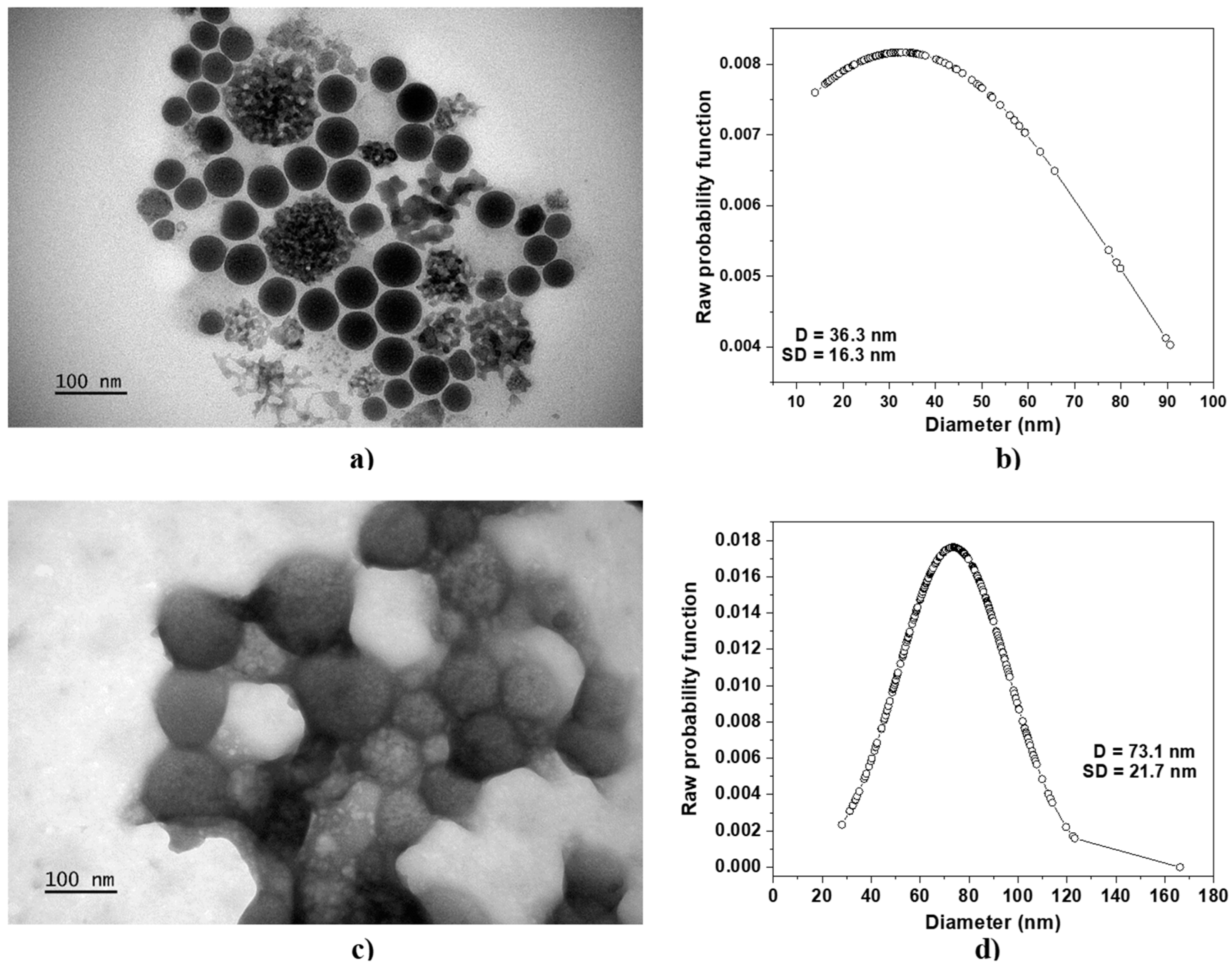

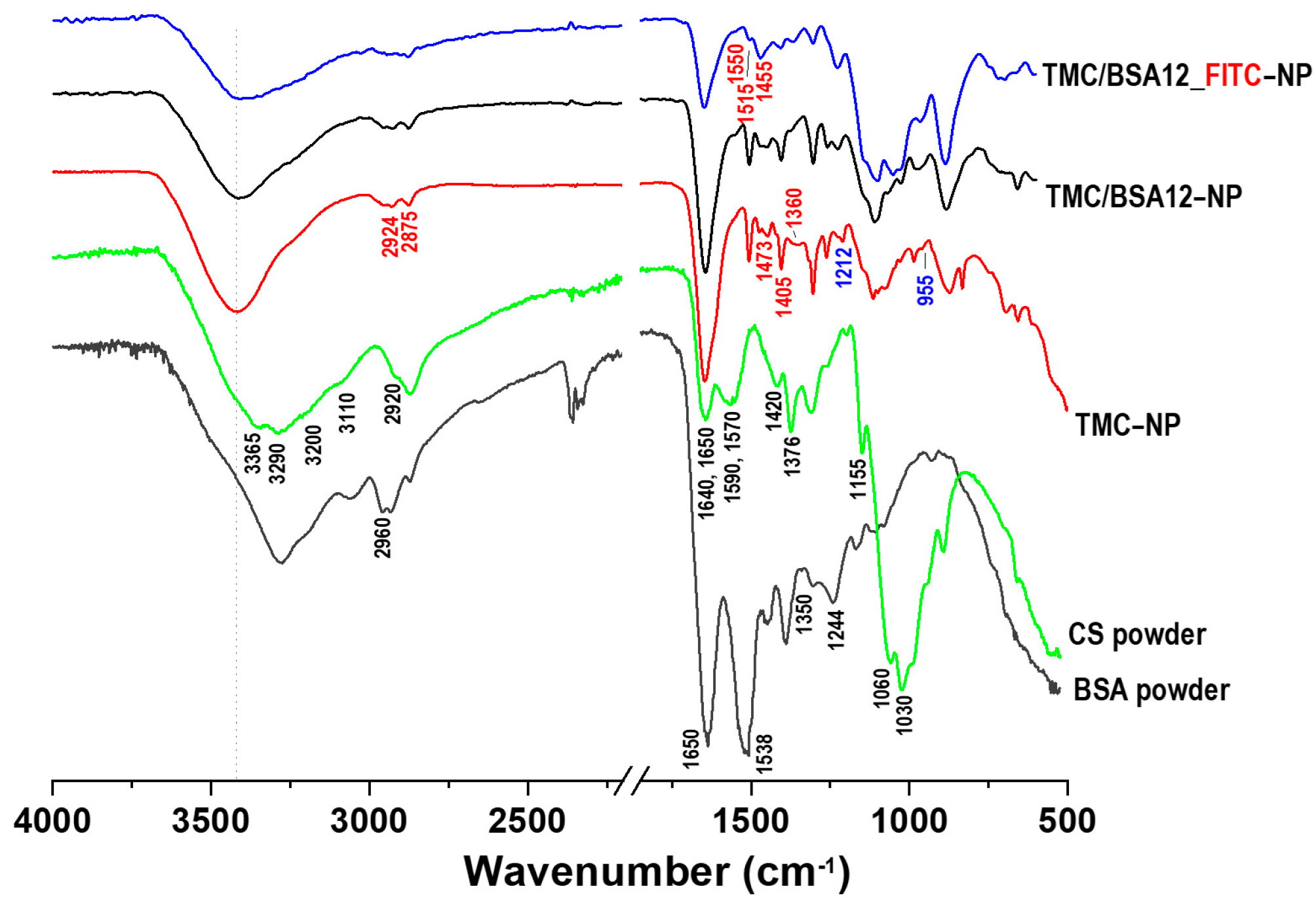
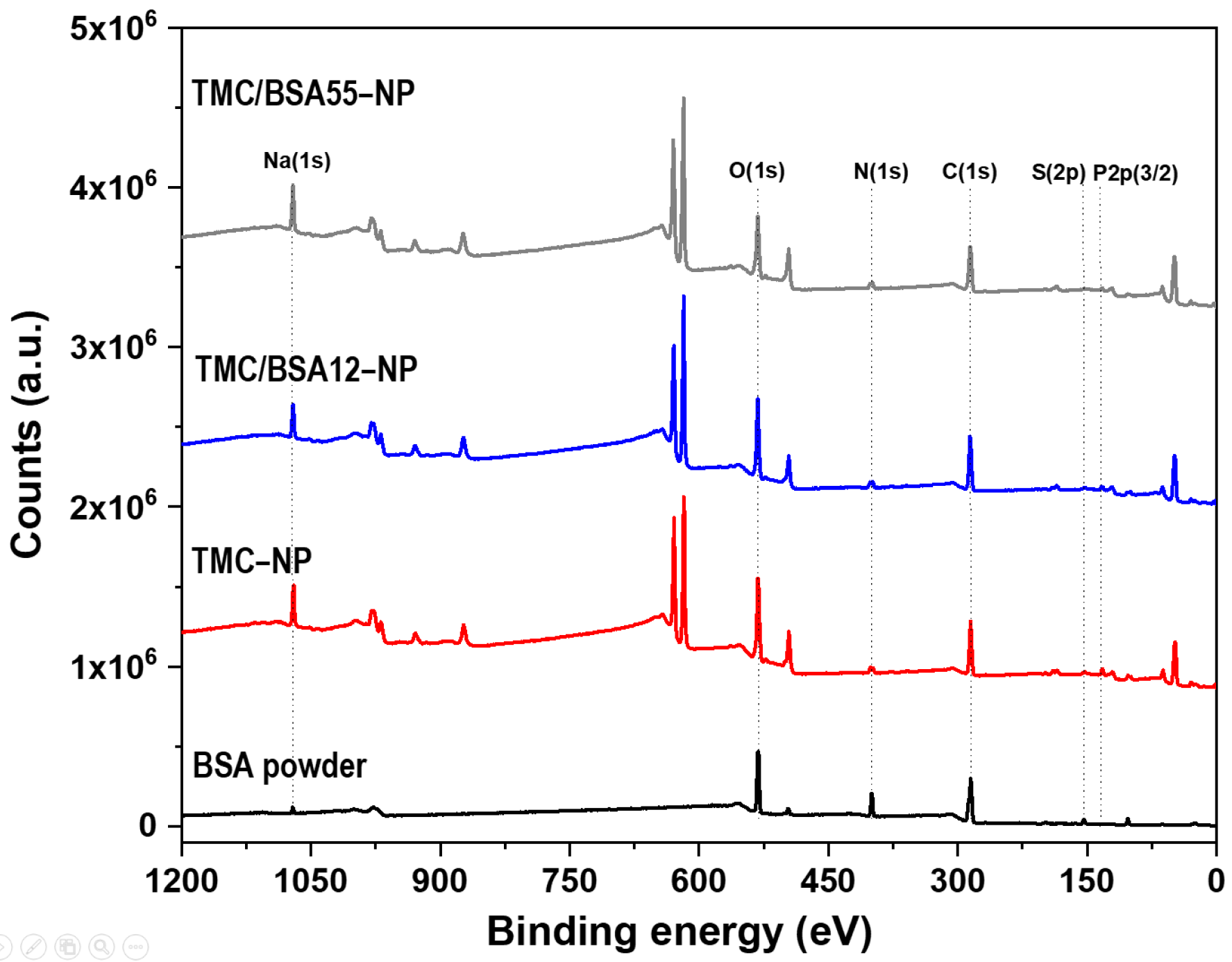
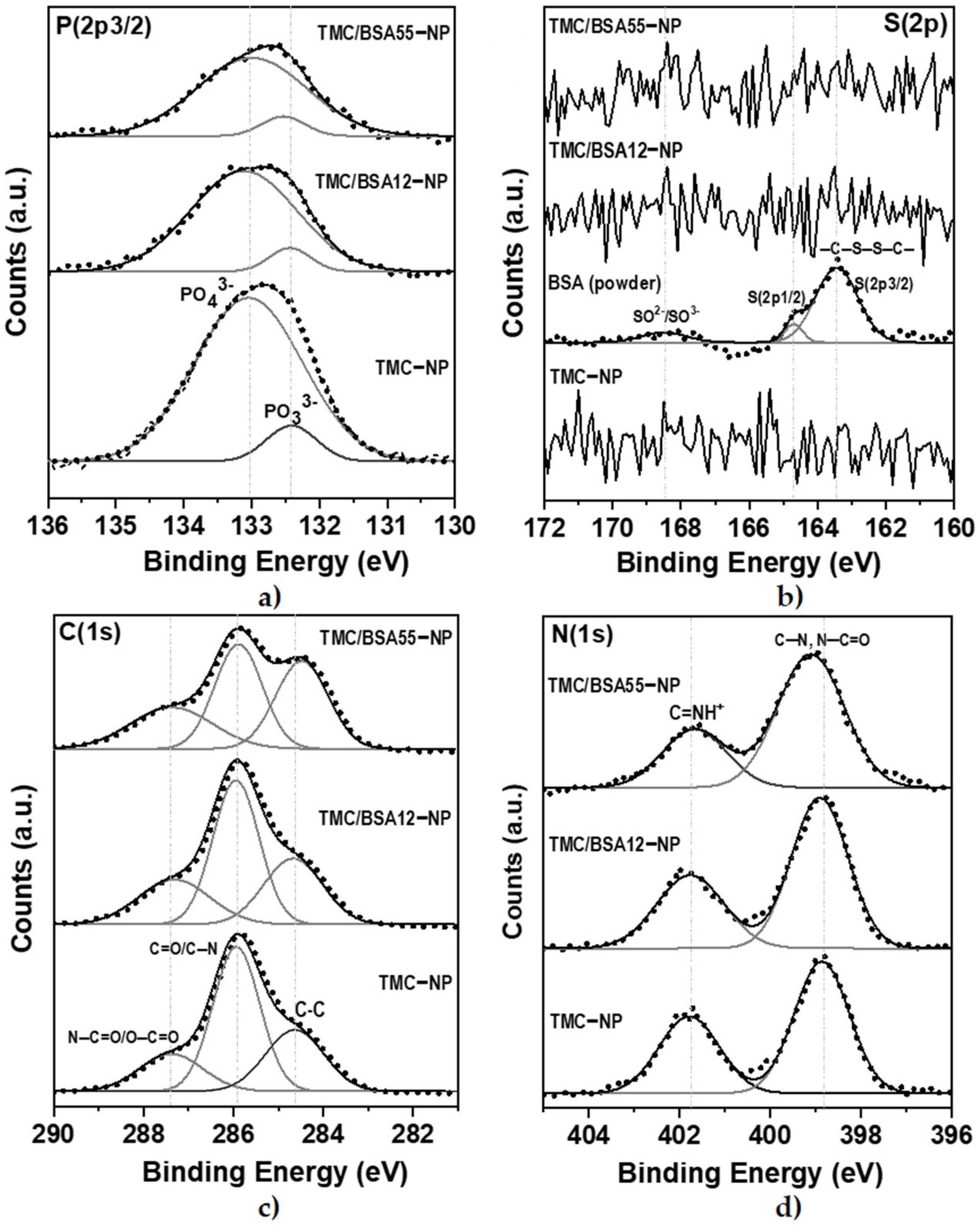
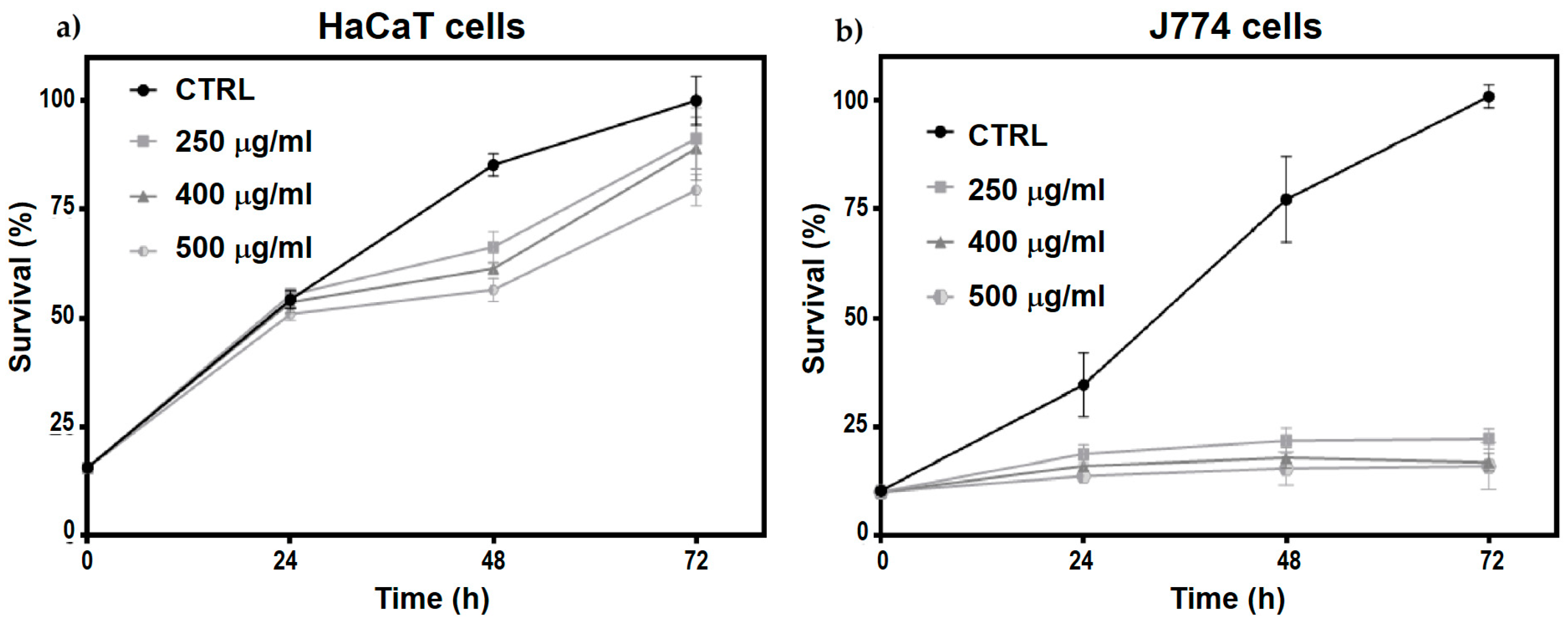
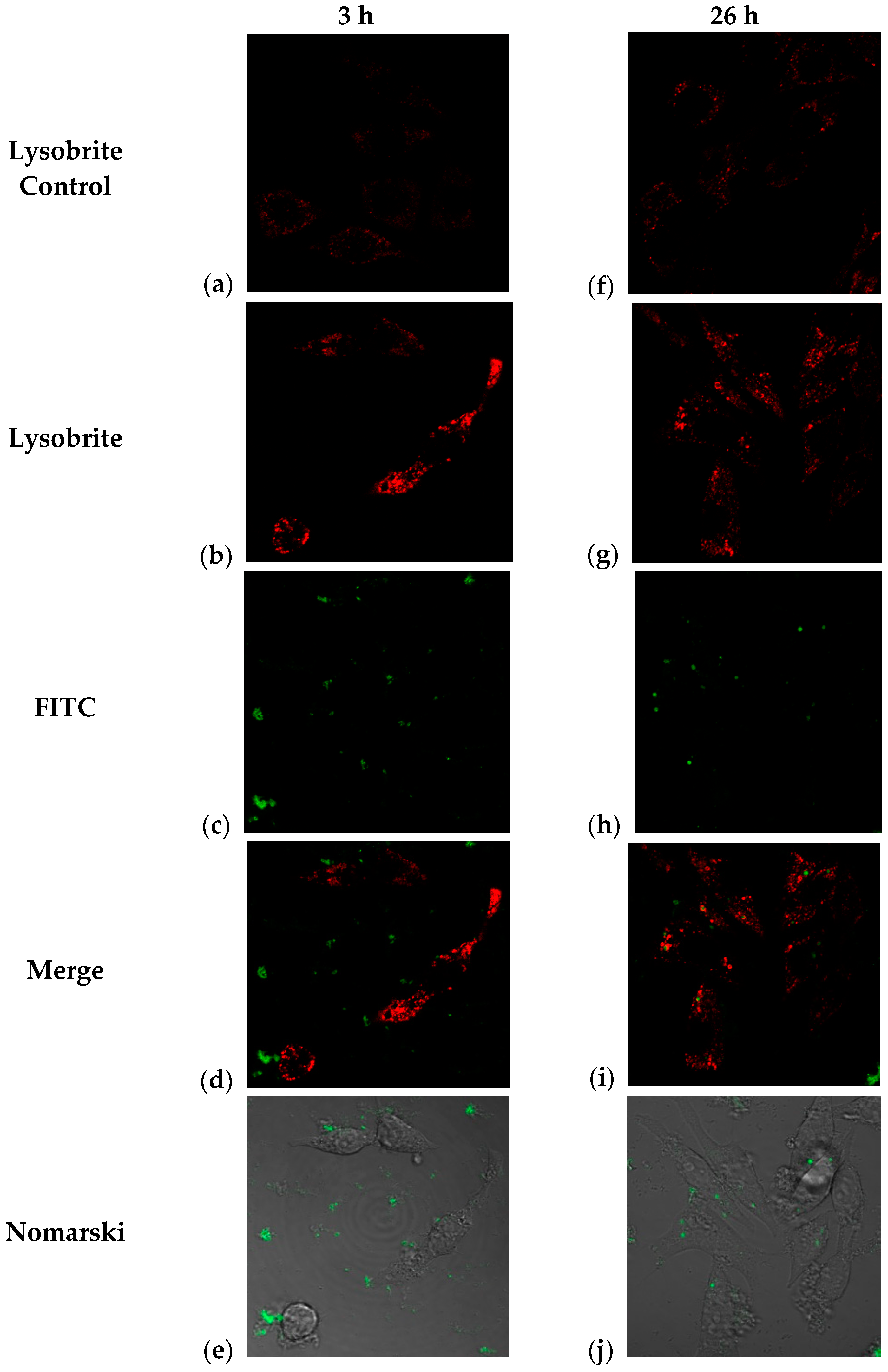
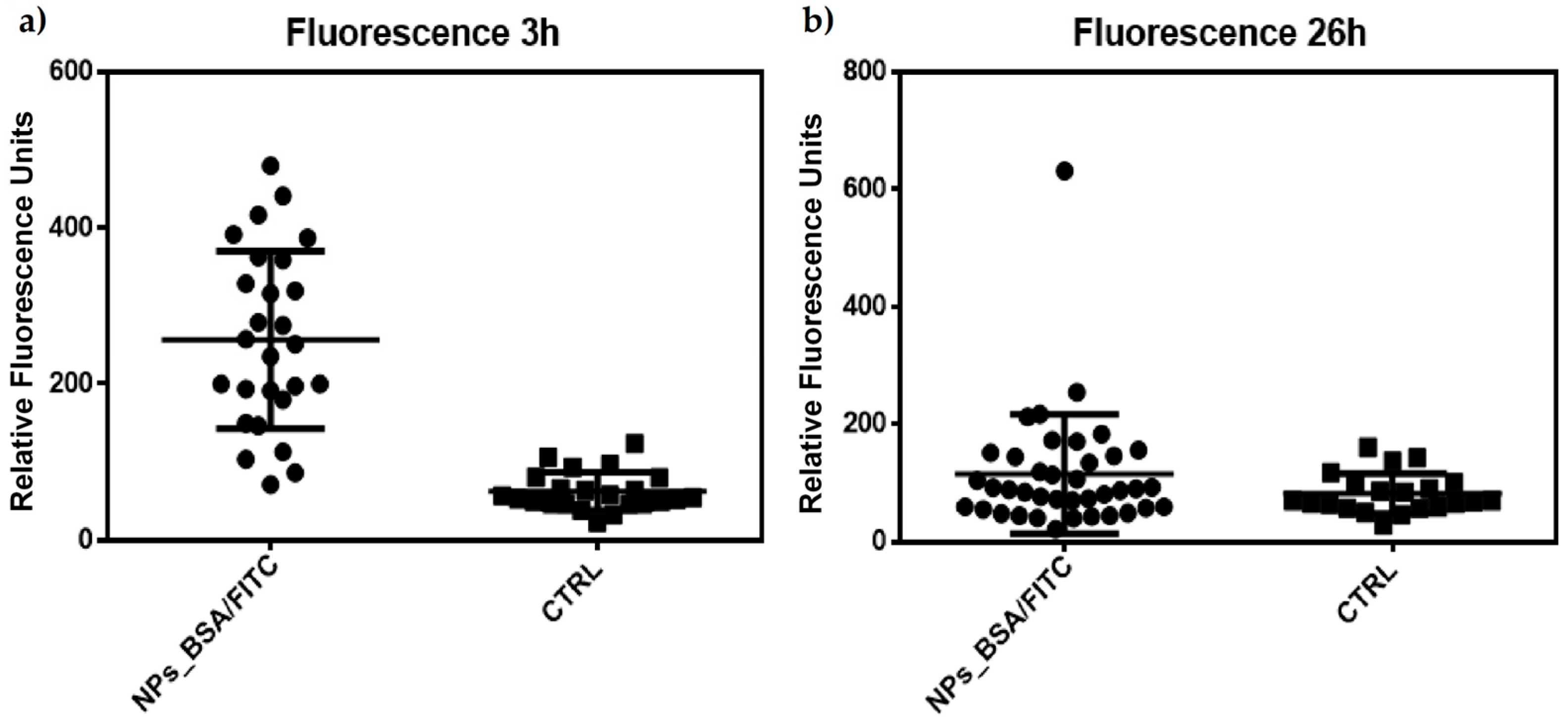
| Sample | Average Diameter, D [nm] | Standard Deviation, SD [nm] | Mean Absolute Deviation, MAD [nm] |
|---|---|---|---|
| TMC−NP | 36.3 | 16.3 | 12.5 |
| TMC/BSA12−NP | 73.1 | 21.7 | 17.6 |
| TMC/BSA12_FITC−NP | 71.7 | 26.1 | 18.8 |
| TMC/BSA55−NP | 179.7 | 119.3 | 92.7 |
| Degradation Stages | Samples | |||||||||||
|---|---|---|---|---|---|---|---|---|---|---|---|---|
| CS (Powder) | TMC (Powder) | TMC−NP | TMC/BSA12−NP | TMC/BSA12_ FITC−NP | TMC/BSA55−NP | |||||||
| T [°C] | Mass Fraction | T [°C] | Mass Fraction | T [°C] | Mass Fraction | T [°C] | Mass Fraction | T [°C] | Mass Fraction | T [°C] | Mass Fraction | |
| 1st | 62.9 | 4.7 | 104.6 | 20.4 | 49.3 | 0.5 | 70.8 | 16.8 | 61.2 | 13.7 | 52.1 | 0.8 |
| 2nd | 303.4 | 31.6 | 165.9 | 45.4 | 84.5 | 2.6 | 119.9 | 28.5 | 114.0 | 33.7 | 113.7 | 5.1 |
| 3rd | 630.0 | 58.7 | 281.0 | 69.0 | 111.6 | 4.9 | 133.0 | 32.0 | 190.1 | 50.2 | 181.9 | 10.4 |
| 4th | -- | -- | 524.5 | 76.5 | 178.5 | 10.9 | 258.6 | 10.9 | 246.8 | 63.0 | 260.0 | 22.3 |
| 5th | -- | -- | 800.0 | 85.0 | 262.1 | 22.9 | 319.2 | 22.9 | 323.7 | 71.8 | 437.4 | 33.4 |
| 6th | -- | -- | -- | -- | 489.1 | 35.7 | 422.0 | 48.2 | 471.4 | 85.2 | 603.2 | 42.3 |
| 7th | -- | -- | -- | -- | 552.6 | 39.1 | 800.0 | 53.3 | 600.0 | 100.0 | 800.0 | 44.0 |
| 8th | -- | -- | -- | -- | 635.7 | 43.6 | -- | -- | -- | -- | -- | -- |
| Element | Concentration [%] | ||
|---|---|---|---|
| TMC−NP | TMC/BSA12−NP | TMC/BSA55−NP | |
| S(2p) | 0 | 0 | 0 |
| C(1s) | 33.2 | 39.1 | 40 |
| N(1s) | 5.4 | 6 | 6.2 |
| O(1s) | 57.9 | 52.7 | 52 |
| P(2p3/2) | 3.5 | 2.2 | 1.8 |
| N/C ratio | 0.162 | 0.153 | 0.155 |
| C/O ratio | 0.573 | 0.742 | 0.8 |
| Time (h) | CTRL vs. 250 µg (J774) | CTRL vs. 400 µg (J774) | CTRL vs. 500 µg (J774) | CTRL vs. 250 µg (HaCaT) | CTRL vs. 400 µg (HaCaT) | CTRL vs. 500 µg (HaCaT) |
|---|---|---|---|---|---|---|
| 0 | 0.595543 | 0.525543 | 0.522477 | 0.839232 | 0.787912 | 0.97329 |
| 24 | <0.0001 | <0.0001 | <0.0001 | 0.20449 | 0.690104 | 0.000638072 |
| 48 | <0.0001 | <0.0001 | <0.0001 | <0.0001 | <0.0001 | <0.0001 |
| 72 | <0.0001 | <0.0001 | <0.0001 | 0.000380315 | <0.0001 | <0.0001 |
Disclaimer/Publisher’s Note: The statements, opinions and data contained in all publications are solely those of the individual author(s) and contributor(s) and not of MDPI and/or the editor(s). MDPI and/or the editor(s) disclaim responsibility for any injury to people or property resulting from any ideas, methods, instructions or products referred to in the content. |
© 2024 by the authors. Licensee MDPI, Basel, Switzerland. This article is an open access article distributed under the terms and conditions of the Creative Commons Attribution (CC BY) license (https://creativecommons.org/licenses/by/4.0/).
Share and Cite
Magaña-Trejo, B.I.; Tenorio-Barajas, A.Y.; Cisneros, B.; Altuzar, V.; Tomas-Velázquez, S.; Mendoza-Barrera, C.; Garrido, E. Lysosomal Activation Mediated by Endocytosis in J774 Cell Culture Treated with N-Trimethyl Chitosan Nanoparticles. Molecules 2024, 29, 3621. https://doi.org/10.3390/molecules29153621
Magaña-Trejo BI, Tenorio-Barajas AY, Cisneros B, Altuzar V, Tomas-Velázquez S, Mendoza-Barrera C, Garrido E. Lysosomal Activation Mediated by Endocytosis in J774 Cell Culture Treated with N-Trimethyl Chitosan Nanoparticles. Molecules. 2024; 29(15):3621. https://doi.org/10.3390/molecules29153621
Chicago/Turabian StyleMagaña-Trejo, Brenda I., Aldo Y. Tenorio-Barajas, Bulmaro Cisneros, Victor Altuzar, Sergio Tomas-Velázquez, Claudia Mendoza-Barrera, and Efrain Garrido. 2024. "Lysosomal Activation Mediated by Endocytosis in J774 Cell Culture Treated with N-Trimethyl Chitosan Nanoparticles" Molecules 29, no. 15: 3621. https://doi.org/10.3390/molecules29153621





